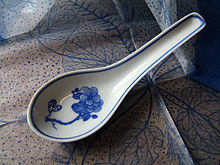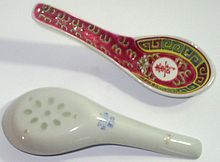- Chinese spoon
-
The Chinese spoon or Chinese soup spoon (Chinese: 中式湯匙; pinyin: zhōngshì tāngchí; literally "Chinese style soup spoon") is a type of spoon used in Chinese cuisine with a short, thick handle extending directly from a deep, flat bowl.[1] It is used for eating soups, stews, or loose solids such as rice, and is commonly made using porcelains and ceramics. Chinese spoons have typically higher sides and can hold more than the common soup spoon.[1] Although typically made as a eating utensil, larger versions of the Chinese spoon are also made as serving spoons or ladles.
Names
The Chinese spoon is known in the Chinese languages as "tāngchí" (Chinese: 湯匙; literally "soup spoon"), but depending on the region or community, the spoon may also be known colloquially as:
- "chí zì" (Chinese: 匙子): which means "little spoon"
- "sháo" (Chinese: 勺), (Chinese: 勺子), (Chinese: 汤勺): which means "ladle", "little ladle", or "soup ladle", respectively.
The Chinese spoon is traditionally and still commonly known by the name that refers to it as an implement for the consumption of the Chinese food, geng (Chinese: 羹):
- "diào gēng" (Chinese: 調羹) which means "carrier of geng"
- "chí gēng" (Chinese: 匙羹) which means "spoon for geng"
 Resting on a spoon rest
Resting on a spoon rest
In Japanese the Chinese spoon is known as chirirenge (Japanese: 散り蓮華, ちりれんげ),[2] which literally means "fallen lotus petal", alluding to its form.
See also
References
- ^ a b Newman, Jacqueline M. (2004). Food culture in China. Westport, Conn.: Greenwood Press. p. 107. ISBN 9780313325816. http://books.google.com/books?id=Jt6u8RZw51cC.
- ^ Heiter, Celeste; Schultz, Marc (2007). The sushi book. San Francisco: ThingsAsian Press. p. 78. ISBN 9781934159002. http://books.google.com/books?id=A96zFxJemHAC.
Categories:- China stubs
- Spoons
- Chinese cuisine
Wikimedia Foundation. 2010.


